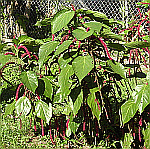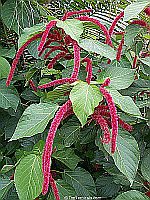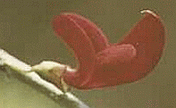

|

Description: Outstanding ornamental shrub; fast growing, up to 4.5 m tall (15 ft) in natural habitat, but in cultivation usually smaller, 1.5-2 m (5-7 ft); grown for its profusion of showy, pendulous, red to purplish inflorescence, 2.5 x 50 cm long (1 in x 20 in); this is the female flower for the male and female flowers are born on separate plants, and the male is not showy and rarely grown; flowering is year round; leaves an attractive vibrant green, are alternate, simple, with pointed tip, up to 22 cm long (9 in); fruit a 3-seeded capsule but usually no fruit since no male plants normally cultivated; all parts of plant poisonous if ingested; in Gardens there are a couple specimen Catstails near the Parrot Aviary.
Plant Family: Belongs to the Euphorbiaceae family, which includes Carapite (Amanoa caribaea), a large tree, dominant in the Dominica rain forest; Cassava (Manihot esculenta); the Castor oil plant (Ricinus communis); and the deadly Madjini or Manchineel (Hyppomane mancinella) - the “Sea Venom” of the Caribs; and to the Spaniards, the “little apple of death", both referring to the fact that the Manchineel is one of the most poisonous trees in the world; (the last three and Catstail are decidedly poisonous, a characteristic of many Euphorbias).
Natural Habitat: Tropical dry forests; propagated by cuttings.
Origin and Distribution: Native to SE Asia, but now a common ornamental throughout Caribbean, and variously throughout the tropics and subtropics also.
Uses: Primarily ornamental; popular for its striking red catstail inflorescence, attractive foliage, and low shrubby habit; medicinally: a wide range of uses; root and flower decoction used in Indonesia to arrest coughing of blood, leaves used in poultices for leprosy; in Malaya, a decoction of leaves and flowers is taken internally as a laxative, and as a diuretic for gonorrhea; bark decoction used as expectorant and to relieve asthma; in Africa, roots used for pulmonary problems; leaves for leprosy, and flowers for kidney ailments and as diuretic.
References:
Dan H. Nicolson. Flora of Dominica, Part 2: Dicotyledoneae. Smithsonian Institution, Washington, D.C. 1991
Robert A. DeFilipps. Useful Plants of the Commonwealth of Dominica, West Indies. Smithsonian Institution, Washington, D.C. 1998
H.F. Macmillan. Tropical Planting and Gardening. Macmillan, London 1956
G.W. Lennox and S.A. Seddon. Flowers of the Caribbean. Macmillan, London 1978
Steve Christman. Acalypha hispida. Floridata.com. Tallahassee, Florida, 1996 (Florida.com, Nov. 2009)
H.M. Burkill. “Acalypha hispida,” in Useful Plants of West Tropical Africa, Vol 2, Royal Botanic Gardens, Kew, UK 1985 (www.aluka.org, Nov. 2009)
|



